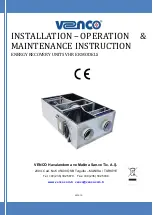
82
■
Rules of digital recording
SCMS (Serial Copy Management System)
As a digital audio component, this unit conforms with the Serial
Copy Management System (SCMS) standards. The Serial Copy
Management System restricts copies made by recording digital
signals to first-generation copies only.
The digital program sources that have been recorded cannot be
digitally recorded again.
There are 2 rules as follows:
Rule 1
Digital sources such as commercially available CDs can be copied
digitally onto other recordable digital media with this unit (a first-
generation digital copy). However, the first-generation digital copy
cannot be copied digitally any further.
Rule 2
The source that was recorded via the ANALOG LINE IN (REC)
jacks can be copied digitally onto other recordable digital media
(a first-generation digital copy). However, the first-generation
digital copy cannot be copied digitally any further.
This unit monitors the SCMS status for each track when a digital
recording is made. If the track is protected from digital recording
and copying, it is not possible to make a digital recording and copy
of that track.
The SCMS standard does not apply to analog recording and
copying.
When making a copy from a CD onto the HDD, or from the HDD
onto a CD-R or CD-RW disc, any of the copy methods described
below can be selected. The following selections are contained in
“Copy Method”.
• “Auto Dig/Anlg”:
Automatically switches to analog recording if the track cannot be
digitally recorded for SCMS.
• “Digital Copy”:
Performs digital copying of only those tracks that can be digitally
copied.
• “Digital Move”:
Performs digital copying of the tracks that cannot be digitally
copied by “Digital Copy” when copying from the HDD onto a
CD-R or CD-RW disc.
• “Analog Copy”:
Performs analog copying regardless of the SCMS standard.
Digital Move
This unit has a built-in HDD with large space that makes a long
recording possible. You can create your own CD by editing the
various program sources that have been recorded onto the HDD of
this unit and copying them onto a CD-R or CD-RW disc.
If you want to make a digital copy of the original data that has been
created on the HDD to a CD-R or CD-RW disc, the “Digital Move”
method is convenient. You can make a digital copy from the HDD
onto a CD-R or CD-RW disc even if the track is protected from
making a second-generation copy by the SCMS standard.
However, since the concept of “Digital Move” is that the data is
moved from the HDD onto a CD-R or CD-RW disc, the original
data on the HDD is erased when moving is complete.
RULES OF DIGITAL RECORDING AND NOTES ON SYSTEM
■
Notes on system
Number and length of recordable discs and
tracks
• One CD-R or CD-RW disc, or one disc on the HDD can be
recorded with up to 99 tracks on them.
• Once 99 tracks have been recorded, no further recording is
possible even if space for recording is available on the disc.
• The minimum length of one track must be 4 seconds. If a
recording is stopped while the track is less than 4 seconds long,
this unit will record for 4 seconds, and then stop recording. The
maximum length of one track is 179 minutes 59 seconds for the
HDD.
• 999 discs can be created at maximum on the HDD of this unit.
However, the number of discs that can be created is limited
according to the space availability (total recordable time) on the
HDD.
• The maximum length of one disc on the HDD is 99 minutes 59
seconds. However, since each track on the HDD is handled in the
unit of frame (75 frames are equal to one second), the maximum
length of one track or disc may vary slightly.
• When recording on a CD-R or CD-RW disc, 2-second silence will
be automatically added to the beginning of the first track.
Therefore the actual total recordable time will be 2 seconds
shorter than the total recordable time of a CD-R or CD-RW disc.
Source sampling rate conversion
• Digital input of this unit supports sampling frequencies of 32kHz,
44.1kHz, 48kHz, and 96kHz. This unit converts these inputs to
the 44.1kHz,16-bit digital signals and records them onto the
HDD, or a CD-R or CD-RW disc.
• Analog input is also converted to the same digital signal to be
recorded.
• This unit outputs the signals at the sampling frequency of
44.1kHz, 16-bit from its digital output.
Recording of non-audio signals
• This unit is designed exclusively for recording audio signals.
Recording is only possible for audio signals.
• When a CD with CD TEXT is copied onto the HDD, CD TEXT
will be automatically copied if it is not copy protected. When a
CD with CD TEXT is recorded from an external CD player, CD
TEXT cannot be copied even if it is not copy protected. To copy
CD TEXT, use the built-in CDR drive of this unit.
• If the digital signals contain graphic data such as CD graphics, the
non-audio signals will not be recorded.
• It is not possible to record from non-audio sources such as CD-
ROM or DVD.
Data processing
• A small amount of space may be used for data processing besides
recording the actual program sources.
• Although this unit is capable of recording 999 albums at
maximum onto the HDD, the data processing speed may slow
down if a large number of albums is created.
108_HD1500(E)76-85.p65
3/20/05, 12:44
82



































